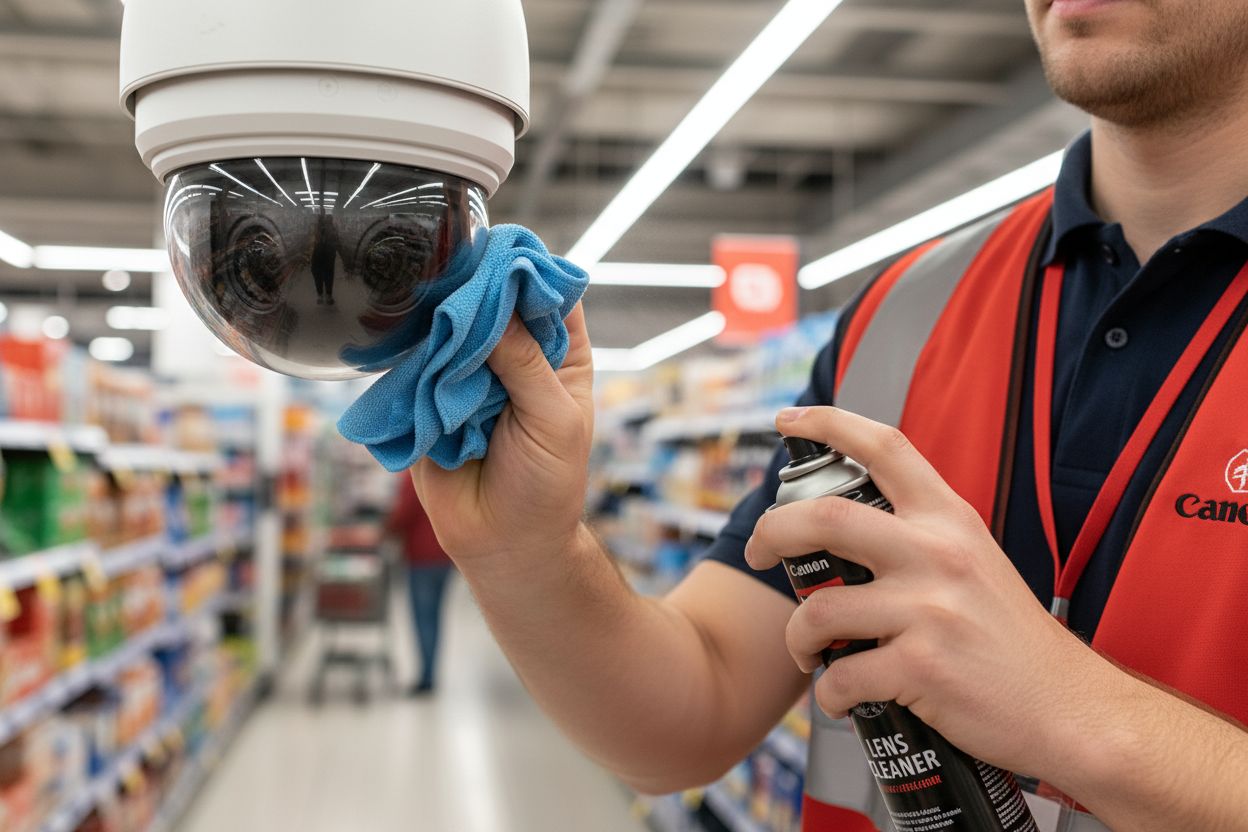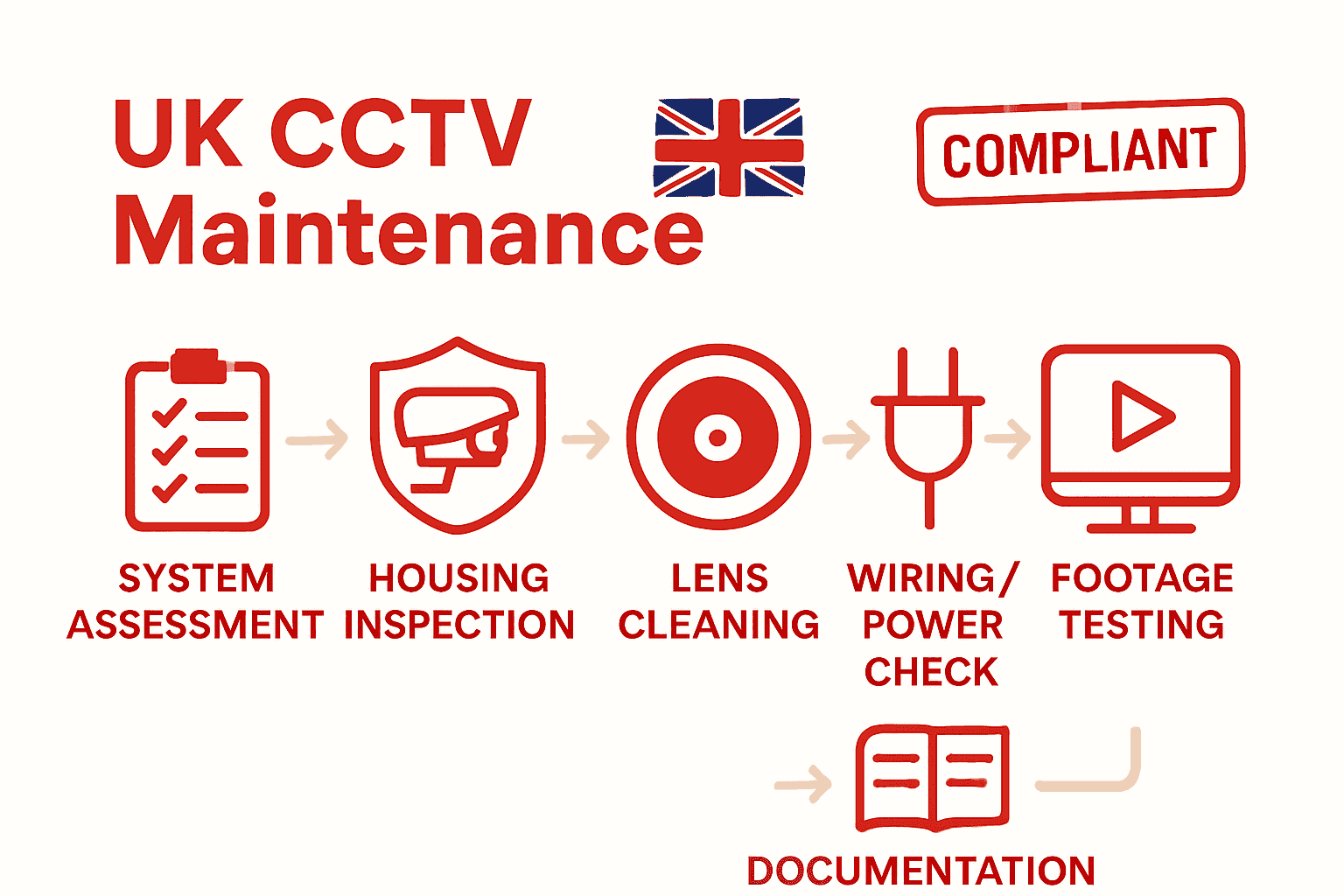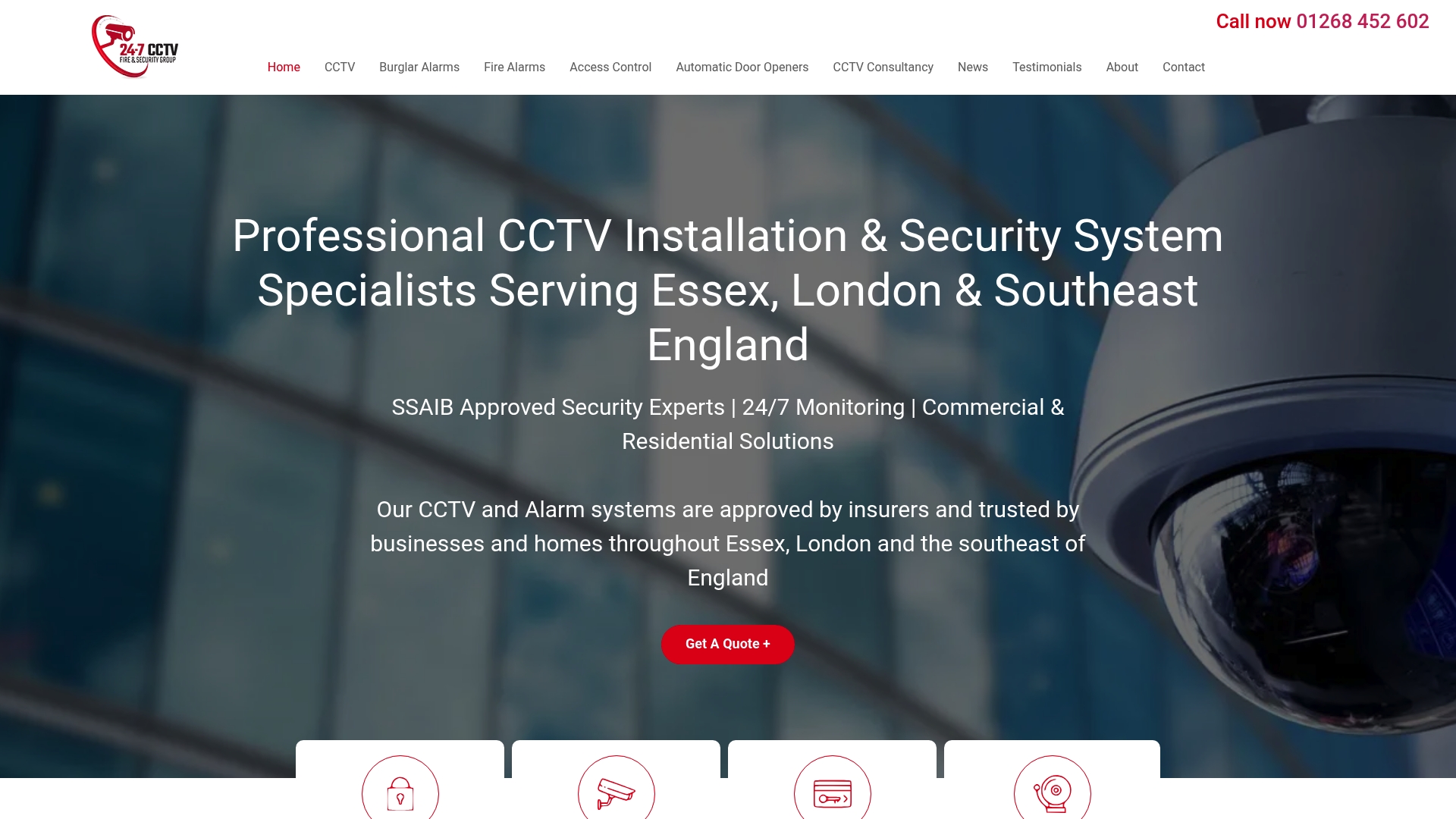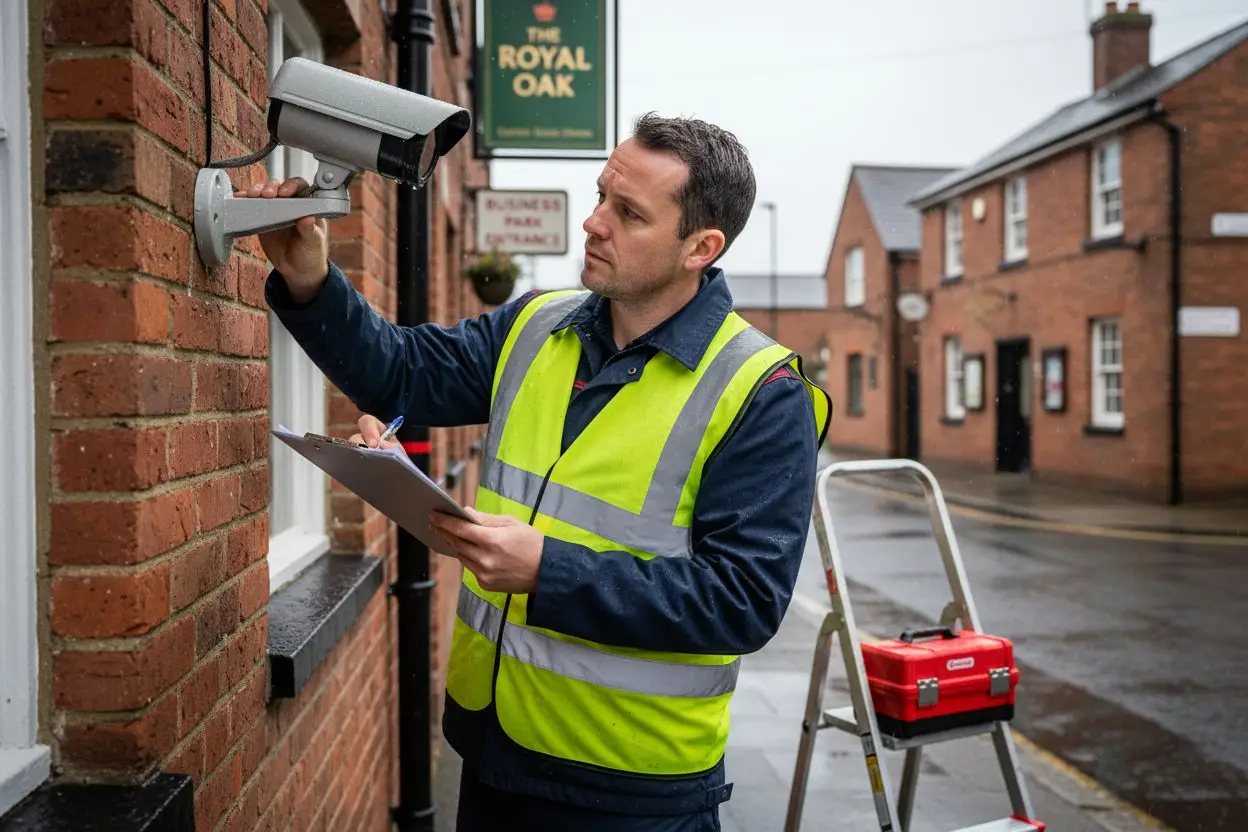Did you know that nearly 60 percent of CCTV failures stem from overlooked maintenance tasks? Regular upkeep is the backbone of an effective security system, protecting both your property and your legal standing. With clear steps and practical tips, maintaining your cameras helps you avoid common pitfalls and keeps your surveillance running smoothly all year round.
Table of Contents
- Step 1: Assess System And Safety Requirements
- Step 2: Inspect Camera Housing And Mounts
- Step 3: Clean Camera Lenses And Domes
- Step 4: Check Wiring And Power Connections
- Step 5: Test Recording And Live Footage
- Step 6: Document Maintenance And Schedule Next Check
Quick Summary
| Key Point | Explanation |
|---|---|
| 1. Assess system performance and compliance | Begin maintenance by reviewing documentation and ensuring your CCTV system meets legal data protection requirements. |
| 2. Inspect camera housing and mounts | Check camera housings for damage and confirm secure, stable mounts to maintain functionality and legal compliance. |
| 3. Clean lenses and domes properly | Regularly clean camera lenses and domes with appropriate materials to ensure clear image quality and operational integrity. |
| 4. Test wiring and power connections thoroughly | Inspect all wiring for damage and ensure proper connections to prevent system failures and maintain continuous surveillance. |
| 5. Document maintenance activities systematically | Keep detailed records of inspections and repairs, and schedule future checks to ensure ongoing system reliability and compliance. |
Step 1: Assess system and safety requirements
In this critical first step of CCTV camera maintenance, you will evaluate the current performance and legal compliance of your security system. Getting this right sets the foundation for reliable surveillance that protects your property and respects data protection regulations.
Begin by gathering comprehensive documentation about your existing CCTV installation. According to the UK Police Requirements, you need to review the system design, installation specifications, and maintenance records. Look for details like camera locations, viewing angles, image resolution, and recording capabilities.
Next, conduct a thorough legal compliance check. As guidance from the Information Commissioner’s Office emphasizes, your system must adhere to data protection laws. This means ensuring:
- Cameras capture only necessary areas
- Signage clearly indicates CCTV monitoring
- Recorded footage is securely stored
- Access to recordings is strictly controlled
Pro Tip: Document every assessment detail. A comprehensive audit trail protects you legally and helps track system improvements over time.
Finally, assess the physical condition of your equipment. Check for:
- Camera lens cleanliness
- Cable integrity
- Mounting stability
- Signs of weather damage or wear
Your next step will involve creating a systematic maintenance plan based on these initial findings.
Step 2: Inspect camera housing and mounts
In this crucial stage of your CCTV maintenance routine, you will carefully examine the physical condition and structural integrity of your camera housings and mounting systems. Proper inspection ensures your surveillance equipment remains secure, functional, and legally compliant.
According to UK Police Requirements, your visual inspection should start with a comprehensive assessment of each camera housing. Begin by checking the external condition of the enclosures. Look for signs of weathering, corrosion, or physical damage that might compromise your system’s performance.
Examine the mounting points meticulously. Check for:
- Structural stability
- Tight mounting brackets
- Even alignment
- No visible rust or metal fatigue
- Secure cable connections
As guidance from the Information Commissioner’s Office emphasizes, these inspections are not just technical maintenance but also support legal compliance with data protection regulations.
Professional Tip: Use a small spirit level to confirm perfect camera alignment. Even slight misalignment can dramatically reduce your surveillance effectiveness.
Pay special attention to outdoor camera housings. Check for water ingress seals, protective coatings, and ensure ventilation mechanisms remain unobstructed. For key maintenance tips to maximise your security installations, remember that environmental protection is as important as mechanical integrity.
Your next step will involve detailed cleaning and potential minor adjustments to maintain optimal system performance.
Step 3: Clean camera lenses and domes
In this critical maintenance stage, you will restore the clarity and performance of your CCTV camera lenses and protective domes. Proper cleaning ensures crisp image quality and maintains the effectiveness of your surveillance system.
According to UK Police Requirements, lens cleaning is not just about aesthetics but fundamental to maintaining operational integrity. Start by gathering the right cleaning materials. You will need microfibre cloths, lens cleaning solution specifically designed for optical surfaces, and soft brushes with non abrasive bristles.
Your cleaning process should follow these careful steps:
- Power down the camera system before cleaning
- Remove loose dust using a soft brush
- Apply lens cleaning solution to your microfibre cloth (never directly onto the lens)
- Gently wipe in circular motions from the centre outward
- Use minimal pressure to prevent scratching
As guidance from the Information Commissioner’s Office emphasizes, maintaining clear visual recordings supports legal compliance and evidence quality.
Professional Tip: Always use lens tissues or microfibre cloths designed for optical surfaces. Regular cloths or paper towels can permanently scratch delicate lens coatings.
Pay special attention to dome housings. These protective coverings accumulate dust and grime that can obscure camera views. Clean them with the same careful technique used for lenses. For comprehensive maintenance tips to maximise your security installations, remember that consistent gentle cleaning prevents long term damage.
Your next step will involve checking and verifying image quality after cleaning to ensure optimal performance.

Step 4: Check wiring and power connections
In this critical maintenance phase, you will thoroughly inspect the electrical infrastructure supporting your CCTV system. Proper wiring and power connection checks are essential to prevent unexpected system failures and ensure continuous surveillance.
According to UK Police Requirements, a systematic approach to electrical inspection is paramount. Begin by visually examining all cable routes from power sources to individual camera units. Look for signs of wear such as fraying, exposed wiring, or environmental damage that could compromise system reliability.
Your comprehensive wiring inspection should cover:
- Cable integrity and insulation condition
- Connection point stability
- Evidence of heat damage or corrosion
- Proper grounding of electrical components
- Secure mounting of power distribution units
As guidance from the Information Commissioner’s Office emphasizes, maintaining robust electrical connections supports both technical performance and legal compliance in surveillance systems.
Professional Tip: Use a multimeter to test voltage consistency and identify potential electrical irregularities before they become critical system failures.
Pay special attention to outdoor camera installations where environmental factors can accelerate cable degradation. Check waterproof seals, conduit connections, and ensure all electrical junctions remain protected from moisture. For additional maintenance tips to maximise your security installations, remember that proactive electrical maintenance prevents costly system interruptions.
Your next step will involve testing system functionality to confirm all connections are operating correctly.
Step 5: Test recording and live footage
In this crucial maintenance stage, you will verify the operational integrity of your CCTV system by thoroughly testing both live and recorded video footage. This step ensures your surveillance system captures clear evidence and functions exactly as expected.
According to UK Police Requirements, comprehensive footage testing involves multiple systematic checks. Start by accessing your recording system and reviewing recent footage for image clarity, frame rate consistency, and accurate time stamping.
Your testing process should include:
- Reviewing recorded footage for visual quality
- Checking time and date accuracy
- Verifying camera angle coverage
- Testing playback functionality
- Confirming storage capacity and archiving
As guidance from the Information Commissioner’s Office emphasizes, maintaining high quality recordings supports legal compliance and potential evidence requirements.
Professional Tip: Always test recording during different lighting conditions to ensure consistent performance from day to night.
Carefully examine live feed quality across all camera locations. Pay special attention to areas with challenging lighting or complex backgrounds. For comprehensive maintenance tips to maximise your security installations, remember that regular testing prevents potential blind spots or recording failures.
Your next step will involve documenting any identified issues and planning necessary system adjustments.
Here’s an at-a-glance summary of each CCTV maintenance step and its main focus:
| Step Number | Main Focus | Key Actions |
|---|---|---|
| Step 1 | System & Safety Assessment | Documentation review Legal compliance check Physical inspection |
| Step 2 | Camera Housing & Mounts | Inspect housings Check mounts Identify weather or damage issues |
| Step 3 | Lens & Dome Cleaning | Clean lenses & domes Use proper materials Restore clarity |
| Step 4 | Wiring & Power Check | Inspect cables Test connections Check grounding |
| Step 5 | Recording & Footage Test | Review live/recorded video Check coverage Test playback |
| Step 6 | Documentation & Scheduling | Log activities Record issues Set next maintenance date |
Step 6: Document maintenance and schedule next check
In this final stage of your CCTV maintenance process, you will systematically record all maintenance activities and establish a strategic schedule for future system checks. Proper documentation ensures ongoing system reliability and supports legal compliance.
According to UK Police Requirements, comprehensive maintenance documentation should include detailed records of every inspection and repair performed. Create a dedicated maintenance log that captures specific details such as date of inspection, technician name, equipment checked, issues discovered, and actions taken.
Your documentation should encompass:
- Date of current maintenance
- Names of personnel involved
- Specific equipment inspected
- Identified issues or potential concerns
- Repairs or adjustments made
- Recommended follow up actions
As guidance from the Information Commissioner’s Office emphasizes, maintaining accurate records supports data protection compliance and demonstrates proactive system management.
Professional Tip: Use a digital spreadsheet or dedicated maintenance management software to track your CCTV system history consistently and efficiently.
Schedule your next maintenance check based on manufacturer recommendations and your system’s specific usage patterns. For comprehensive maintenance tips to maximise your security installations, consider setting recurring quarterly or bi annual checks to prevent potential system failures.
Your maintenance documentation will serve as a critical reference for future technical assessments and demonstrate your commitment to maintaining a robust surveillance system.

Secure Your CCTV System with Expert Installation and Support
Maintaining a CCTV system involves careful checks on everything from camera alignment to legal compliance. If the process of documenting inspections, cleaning lenses, or testing footage feels overwhelming, you are not alone. Many UK businesses and homeowners share the challenge of keeping their surveillance reliable and fully operational while meeting strict safety standards and data protection rules.
Don’t risk blind spots or system failures that jeopardise your security. With over years of experience installing CCTV, burglar alarms and access control systems, we at 247 CCTV understand the importance of a professionally installed and maintained system that performs exactly when needed.

Take the next step in securing your site today by contacting us for a tailored CCTV installation or maintenance package. Rely on expert advice to ensure your setup complies with UK Police and data protection guidelines. Visit us at 247 CCTV and discover how we can help maximise your security system’s lifespan and effectiveness with reliable solutions designed for UK environments.
Frequently Asked Questions
How often should I perform CCTV camera maintenance?
You should perform CCTV camera maintenance at least once every six months. This routine check helps ensure optimal performance and can identify potential issues before they escalate.
What are the key steps in the CCTV camera maintenance process?
The key steps include assessing system requirements, inspecting camera housing and mounts, cleaning lenses and domes, checking wiring and power connections, testing recordings, and documenting maintenance activities. Follow these steps systematically to maintain the functionality of your CCTV system.
How can I ensure my CCTV system is compliant with data protection laws?
To ensure compliance, regularly review that your CCTV setup captures only necessary areas, has clear signage indicating monitoring, stores footage securely, and controls access to recordings. Conduct this review at least annually to maintain compliance with current regulations.
What supplies do I need for cleaning CCTV camera lenses and domes?
For cleaning, gather microfiber cloths, lens cleaning solution, and soft brushes. Use these tools to remove dust and grime gently, maintaining optimal image quality.
How can I document CCTV maintenance effectively?
Create a dedicated maintenance log that captures the date, personnel involved, equipment checked, and any identified issues. Regularly update this documentation during each maintenance session to keep accurate records.
What should I check when inspecting camera wiring and power connections?
Inspect all cable routes for wear, check connection stability, and look for signs of heat damage or corrosion. Ensure that all connections are secure and properly grounded to prevent electrical failures.
Recommended
- Key Maintenance Tips to Maximise the Lifespan of Your Security Installations – 247 CCTV Security Ltd
- CCTV Maintenance in Essex | 247 CCTV Security
- The Essential Guide to Home CCTV in the UK – 247 CCTV Security Ltd
- Maximize Your Security Investment: Essential Preventive Maintenance Strategies – 247 CCTV Security Ltd

